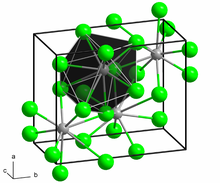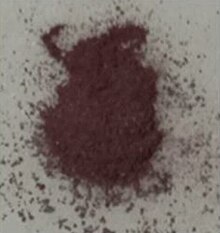
| |

| |
| Names | |
|---|---|
| IUPAC name
Samarium(II) chloride
| |
| Other names
Samarium dichloride
| |
| Identifiers | |
3D model (JSmol)
|
|
| ChemSpider | |
| ECHA InfoCard | 100.034.196 |
| EC Number |
|
PubChem CID
|
|
CompTox Dashboard (EPA)
|
|
| |
| |
| Properties | |
| SmCl2 | |
| Molar mass | 221.27 g/mol |
| Appearance | dark brown crystals[1] |
| Density | 3.69 g/cm3, solid |
| Melting point | 855 °C (1,571 °F; 1,128 K) |
| Boiling point | 1,310 °C (2,390 °F; 1,580 K) |
| ? | |
| Structure | |
| Orthorhombic | |
| Pbnm, No. 62[2] | |
| Related compounds | |
Other anions
|
Samarium(II) bromide Samarium(II) iodide |
Other cations
|
Samarium(III) chloride |
Except where otherwise noted, data are given for materials in their standard state (at 25 °C [77 °F], 100 kPa).
| |
Samarium(II) chloride (SmCl2) is a chemical compound, used as a radical generating agent in the ketone-mediated intraannulation reaction.